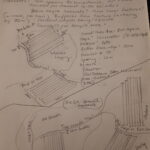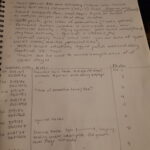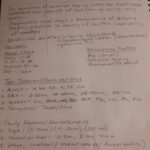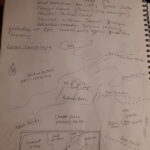My original plan to focus on an area close to my home and look at the localized effect of springs on vegetation layer/composition became difficult with the fluctuating weather patterns in January.
After my initial post I visited another site of interest near my home at Larch Hills. I put up a motion wildlife camera in an area of old growth forest on February 1st. The camera was focused where I previously identified weasel and rabbit tracks. My plan was to see if I could capture any footage of American Marten as I’m curious if they are present around the cross country ski area. There are large stands of intact old growth and mature Cedar Hemlock forest (50 to 100yr), with substantial coarse woody debris piles for subnivean habitat – which are important features for Marten in winter.
Upon checking on the camera and traversing a large area of the forest along the riparian zone at the headwaters of Violet Creek on February 6th, I was excited to see that there were images of Flying squirrels, Ermine, and Stellars Jays.
Reflecting on these findings, I began thinking about a research question around an important keystone feature of the forest for sensitive species like American marten – being tree cavities. There are many other species associated with the BEC zone at Larch Hills that rely on tree cavities for nesting as well. Nesting cavities can be studied during the transitional season of winter to spring, in accessible areas at Larch Hills. My new plan is to compare abundance and characteristics of nesting tree cavities (differentiated from roosting/feeding cavities) across various seral stages of ICHmw4 (BEC zone) study areas, as well as within recently selectively harvested sites. The objective will be to identify patterns that show impacts of forest management activities in the area (recent selective logging, regeneration stands) on cavity dependent species.
My hypothesis is: The abundance of nesting cavities in trees is impacted negatively by selective forest harvesting activities in mature stands within the ICHmw4 BEC zone, limiting availability of this crucial habitat feature for cavity dwelling species.
Formal prediction: The data I collect will show considerably less viable nesting cavities within the sample area of mature ICH forest that is selectively logged, compared to another intact mature stand of ICH on a similar aspect, slope gradient, and of similar successional stage. Old growth stands will show a higher abundance of nesting cavities due to older decay class trees. Mid age stands may exhibit more cavities as the 1st generation of successional deciduous species is dying? Young regeneration forest will not have any cavities.
Potential response variable: The number (viable nesting size) of tree cavities for nesting. Continuous.
Potential explanatory variable: The forest type and disturbance level (ie. seral stage – early/mid/mature/old growth, selectively logged, natural vs. managed). Categorical.



